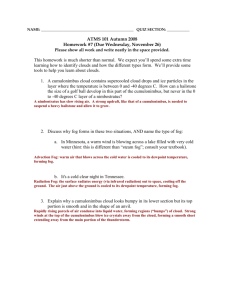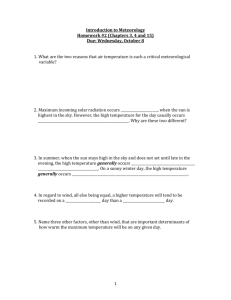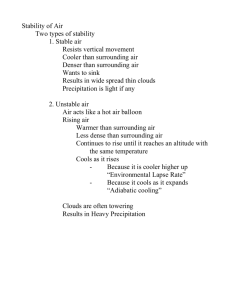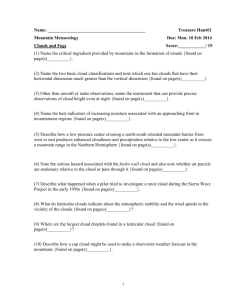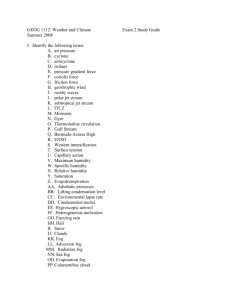5.04 Clouds and Fog - 223 Red Lion Squadron
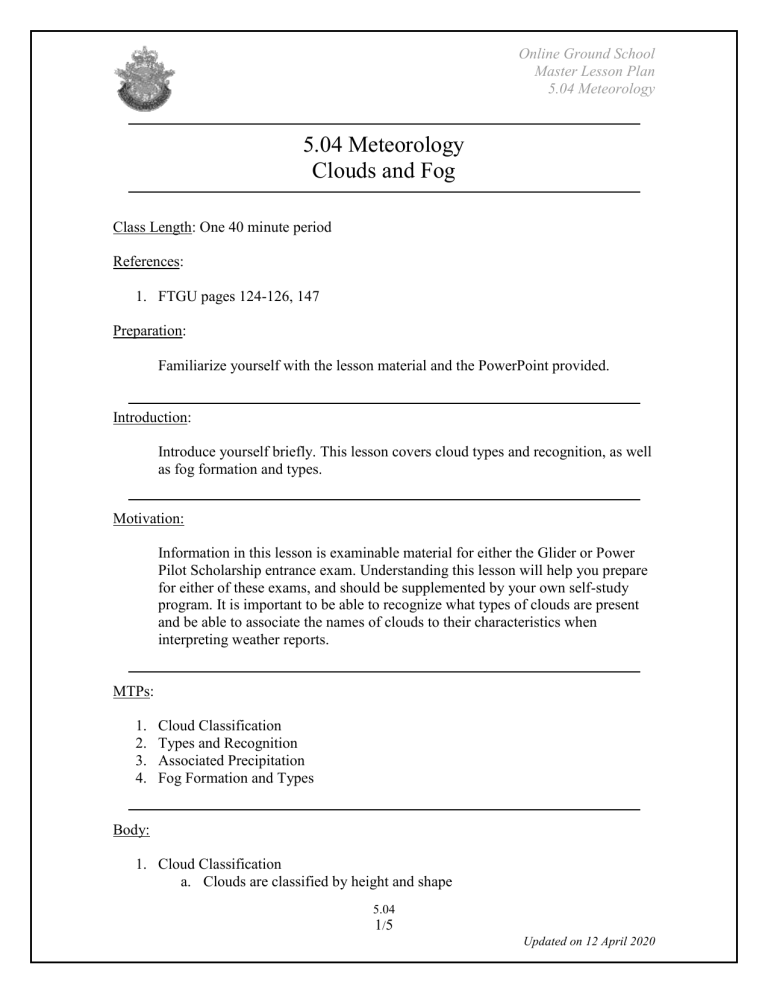
Online Ground School
Master Lesson Plan
5.04 Meteorology
5.04 Meteorology
Clouds and Fog
Class Length: One 40 minute period
References:
1.
FTGU pages 124-126, 147
Preparation:
Familiarize yourself with the lesson material and the PowerPoint provided.
Introduction:
Introduce yourself briefly. This lesson covers cloud types and recognition, as well as fog formation and types.
Motivation:
Information in this lesson is examinable material for either the Glider or Power
Pilot Scholarship entrance exam. Understanding this lesson will help you prepare for either of these exams, and should be supplemented by your own self-study program. It is important to be able to recognize what types of clouds are present and be able to associate the names of clouds to their characteristics when interpreting weather reports.
MTPs:
1.
Cloud Classification
2.
Types and Recognition
3.
Associated Precipitation
4.
Fog Formation and Types
Body:
1.
Cloud Classification a.
Clouds are classified by height and shape
5.04
1 / 5
Updated on 12 April 2020
Online Ground School
Master Lesson Plan
5.04 Meteorology b.
Two cloud types i.
Cumulus
1.
Round, resemble cotton balls, form in rising air ii.
Stratus
1.
Flat, form sheets, form in stable air c.
Four cloud families i.
High (Cirro)
1.
bases between 16 500 and 45 000 feet
2.
Ice crystals ii.
Middle (Alto)
1.
Bases between 6500 and 23 000 feet
2.
Ice crystals, water droplets iii.
Low (Strato)
1.
Bases from surface to 6500 feet iv.
Clouds of Vertical Development
1.
May form as low as 1500 feet
2.
Water droplets above freezing
2.
Types and Recognition a.
High Clouds i.
Cirrus (Ci)
1.
very thin wispy cloud, like it was made with an artist’s brush
2.
sometimes referred to as cats’ whiskers or mares’ tail
3.
generally no particular significance to flying ii.
Cirrocumulus (Cc)
1.
thin cotton like clouds
2.
looks like pattern of the sand at a beach
3.
no indication of future weather conditions iii.
Cirrostratus (Cs)
1.
thin high sheet of cloud
2.
sun or moon is visible, producing a halo effect
3.
often indicate an approaching warm front or occlusion and therefore of deteriorating weather conditions iv.
Middle Clouds
1.
Altocumulus (Ac) a.
layers of rounded masses of cloud that may lie in groups or lines b.
sometimes associated with an approaching front but usually they have little value as a weather predictor
2.
Altocumulus Castellanus (Acc) a.
altocumulus with turreted edges b.
may develop into cumulonimbus c.
a variation of AC with greater vertical extent d.
characteristics include: instability, turbulence and shower activity
5.04
2 / 5
Updated on 12 April 2020
Online Ground School
Master Lesson Plan
5.04 Meteorology v.
Low Clouds
1.
Status (St) a.
uniform layer of low cloud resembling fog but is not touching the ground b.
low visibility, drizzle and fog often associated
2.
Stratocumulus (Sc) a.
layer or series of rounded masses or rolls of cloud b.
common in high pressure areas in winter c.
sometimes gives a little precipitation
3.
Nimbostratus (Ns) a.
‘Nimbo’ – means precipitation is associated with the cloud b.
low dark grey layer c.
thickened altostratus d.
associated with warm fronts and continuous/steady rain or snow e.
may be more than 15,000 ft thick f.
VFR operations often difficult to impossible vi.
Clouds of Vertical Development
1.
Cumulus (Cu) a.
Dense, thick, rounded and lumpy b.
resembles cotton balls c.
flat bases and sharp clear cut surfaces d.
forming during day and dissipate at night e.
height of base depends on temperature and dew point spread f.
light to moderate turbulence g.
NO PRECIPITATION
2.
Towering Cumulus (TCu) a.
a development of cumulus cloud b.
serious (moderate to heavy) icing and turbulence c.
rain showers and snow showers in winter d.
rough air underneath
3.
Cumulonimbus (Cb) a.
development of TCU b.
often anvil shape top c.
produces lightning and thunder d.
gusty surface winds in vicinity e.
hail is often present within the cloud and may occasionally fall from it f.
heavy icing, turbulence and showers g.
may be embedded in stratiform clouds h.
cloud should be avoided
3.
Associated Precipitation
5.04
3 / 5
Updated on 12 April 2020
Online Ground School
Master Lesson Plan
5.04 Meteorology
4.
Fog Formation and Types a.
Fog is: Cloud (usually stratus) in contact with ground b.
Formed when either: i.
Air is cooled to the due point, or
1.
Radiation Fog
2.
Advection Fog
3.
Upslope Fog ii.
Air becomes saturated (moisture added)
1.
Steam Fog
2.
Ice Fog
3.
Precipitation-induced Fog c.
Types i.
Radiation Fog (ground fog)
1.
Forms at night a.
Initial heating from sun causes turbulence
2.
Ground cools losing heat through radiation a.
Air in direct contact is cooled
3.
Clear skies, moist air, light winds (2-5 knots) ii.
Advection Fog
1.
When warm moist air moves over a colder land or sea surface
2.
Winds >15 knots
3.
Most frequent in costal regions
4.
Widespread when moist air from warm region of ocean moves over colder water iii.
Precipitation Induced Fog (frontal fog)
1.
Addition of moisture to air through evaporation of rain or drizzle
2.
The precipitation from warm air evaporates and saturates cooler air below
3.
Associated mostly with warm fronts
5.04
4 / 5
Updated on 12 April 2020
Online Ground School
Master Lesson Plan
5.04 Meteorology iv.
Upslope Fog
1.
Cooling of air due to expansion as it move sup slope
2.
Light upslope wind required v.
Steam Fog
1.
Cold air passes over warm water surface
2.
Evaporation of water into air until saturated
3.
Occurs over rivers and lakes, especially during autumn vi.
Ice Fog
1.
Moist air during extremely cold calm conditions
2.
The cold air cannot hold more moisture and excess sublimates into ice crystals
3.
Crystals appear suddenly when engine started a.
Water vapour b.
Condensation nuclei c.
Mixing agent
Confirmation:
1.
What are the names for the 3 levels of clouds? a.
High (Cirro) b.
Middle (Alto) c.
Low (Strato)
2.
Name one type of cloud of vertical development a.
Cumulus, Towering Cumulus, Cumulonimbus
3.
What type of precipitation would you get in a.
Stratus clouds i.
Steady, drizzle like precipitation b.
Cumulus clouds i.
None, Cumulus clouds produce no precipitation. However,
Cumuliform clouds such as Alto Cumulus, Towering Cumulus or
Cumulonimbus clouds produce showers of heavier precipitation
Conclusion:
This lesson covered cloud types and recognition, as well as fog formation and types. It is important to be able to recognize what types of clouds are present and be able to associate the names of clouds to their characteristics when interpreting weather reports. Understanding this lesson will help you prepare for a flying scholarship entrance exam, and should be supplemented by your own self-study program. If you have any questions, you can direct them to emailonlinegroundschool@gmail.com
.
5.04
5 / 5
Updated on 12 April 2020



